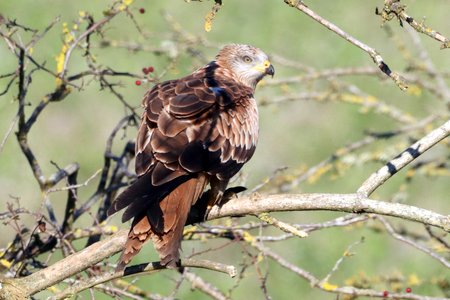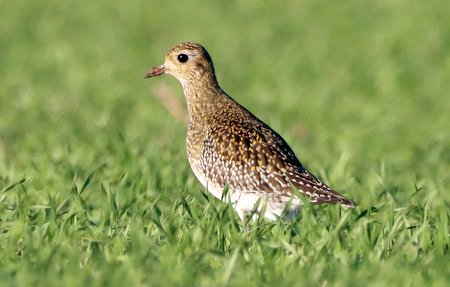As of 23rd February 2016, the Wiltshire List stood at 329 species.
The information on birds seen for the first time in the last 10 years is summarised in this table.
|
Year |
Species |
Date seen |
Total |
Notes |
|
2007 |
Lesser Scaup |
February 2007 |
316 |
|
|
2008 |
Penduline Tit |
April 2008 |
317 |
|
|
Thrush Nightingale |
August 2008 |
318 |
||
|
2009 |
Crested Lark |
November 2009 |
319 |
|
|
2010 |
320 |
See Note 1. |
||
|
2012 |
Pacific Golden Plover |
June 2012 |
321 |
|
|
2013 |
Great Reed Warbler |
September 2013 |
322 |
|
|
2013 |
Pallid Harrier |
September 2013 |
323 |
|
|
2013 |
Isabelline Shrike |
October 2001 |
324 |
See Note 2. |
|
2014 |
Two Barred Crossbill |
January 2014 |
325 |
|
|
2014 |
Red-flanked Bluetail |
February 2014 |
326 |
|
|
2015 |
Spotted Sandpiper |
August 2015 |
327 |
|
|
2016 |
328 |
See Note 3. |
||
|
2016 |
Hooded Merganser |
February 2016 |
329 |
Notes
1. The Siberian Stonechat was split from the European Stonechat. Siberian Stonechat had previously been recorded as a sub-species.
2. The Isabelline Shrike, seen in 201 was accepted as a valid sighting in 2013
3. Bean Goose was split into Taiga Been Goose and Tundra Bean Goose. Both have previously been recorded as sub-species.
Two species — White-tailed Fish-eagle and Chough — were seen in the county in 2007, the first time since 1935 and the mid 19th Century, respectively.
Around 200 species are seen annually in the county:
| Year | 1998 | 1999 | 2000 | 2001 | 2002 | 2003 | 2004 | 2005 | 2006 | 2007 |
| Species | 200 | 206 | 197 | 197 | 199 | 192 | 195 | 200 | 193 | 196 |
| County firsts | 2 | 2 | 0 | 0 | 2 | 0 | 3 | 1 | 0 | 1 |
| Year | 2008 | 2009 | 2010 | 2011 | 2012 | 2013 | 2014 | 2015 | 2016 | |
| Species | 197 | 191 | 191 | 207 | 203 | 200 | 199 | 196 | 201 | |
| County firsts | 2 | 1 | 0 | 0 | 1 | 3 | 2 | 1 | 1 |
For the full list of birds seen in Wiltshire as of February 2016, please see https://www.wiltshirebirds.co.uk/WOS_docs/Wiltshire_Bird_list.pdf
Breeding: 147 (46%) species have nested on at least one occasion, of which 119 (37%) are regular breeders. Seven (2%) are former breeders, three of which (Black Grouse, Great Bustard and Cirl Bunting) are extinct in the county, and four (Corncrake, Wryneck, Marsh Warbler and Red-backed Shrike) still occur as vagrants. Three more (Ring Ouzel, Redwing and Golden Oriole) may also have nested but without there being clear evidence.
Wintering: 125 (39%) species winter regularly in the county. Hooded Crow was once an annual winter visitor, but there have been no recent records.
Residents: 88 (28%) species are both regular breeders and regular in winter.
Migrants: 35 (11%) species are regarded as mainly passage migrants or wanderers, neither breeding nor wintering regularly, although three — Mediterranean and Yellow-legged Gulls, and Crossbill — occur widely outside what are regarded as the normal passage periods.
Vagrants: 125 (40%) species occur very infrequently, ten of which have not been recorded in the county for more than 100 years.
Introductions: 13 (4%) species on the Wiltshire List are 'naturalised'. Three — Greylag and Barnacle Geese, and Rock Dove (Feral Pigeon) — are found naturally elsewhere in Great Britain, but those that occur in Wiltshire are believed to have derived from introduced stock. Ruddy Shelduck is included in this group, although the origins of past records, and the case for genuine vagrancy, remain a much-discussed issue. The Red Kites that breed in Wiltshire also derive from introduced stock but, as part of a deliberate reintroduction programme for conservation purposes, are not included among these 13.
Escapes: a large number of other bird species have also been recorded in the county but, as obvious or likely escapes (many are simply escaped cagebirds) that have not come from self-sustaining populations, these are not included as part of the Wiltshire List.
Submitting records
Records of all birds seen in Wiltshire should be submitted to the County Recorder. Records of rare species are assessed by the WOS Records Panel. For details of what information should be submitted, and a list of those species requiring a description, see Submission of records.
* See the BOURC website for a full explanation of the categories of the British List




